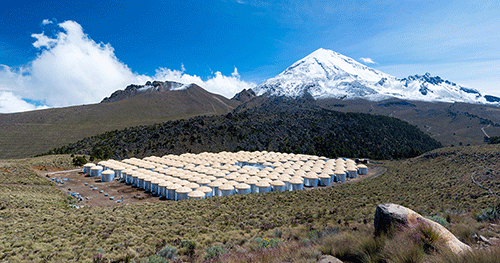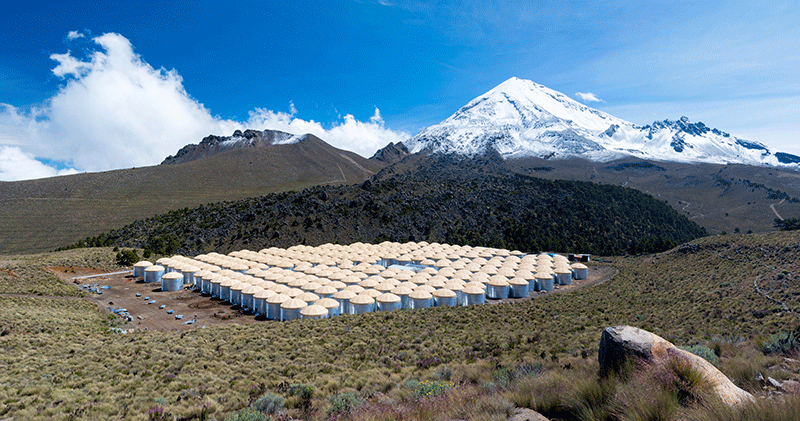Meetings: Highlights from the APS April Meeting 2016
More than a thousand particle physicists, nuclear physicists, and astrophysicists convened in Salt Lake City, Utah, to attend the APS April Meeting. Popular topics included LIGO’s gravitational wave detection, recently discovered exoplanets, and updates from the leading dark matter detection experiments. But the multidisciplinary program also featured talks on best practices for teaching physics and on the modernization of nuclear weapons. Here’s a sampling of this year’s presentations.
–David Ehrenstein and Matteo Rini
New Map of the Gamma-Ray Sky
The most detailed map of the sky, as seen in very-high-energy gamma rays, was released at the meeting by the High Altitude Water Cherenkov Gamma-Ray Observatory (HAWC) Collaboration. The map is based on the observatory’s first year of operation and reveals about 40 sources. Among these, one quarter have never been seen in gamma rays, while many of the others are seen with a new level of detail. The observatory, located in central Mexico, consists of 300 water tanks that detect flashes of light (Cherenkov radiation) when the liquid is struck by secondary particles produced in the atmosphere by gamma rays. HAWC can observe 2/3 of the sky and does so every 24 hours, unlike other ground-based gamma-ray telescopes, which detect gamma-ray-induced flashes in a specific direction and can only operate at night. The observatory is sensitive to gamma rays with energies from approximately 100 GeV to 100 TeV—only its predecessor Milagro has observed such high-energy gamma rays across so much of the sky. The HAWC researchers expect their data to improve understanding of high-energy sources in the cosmos such as gamma-ray bursts, supernova remnants, and supermassive black holes.
The Correlation Between Fracking and Earthquakes
Hydraulic fracturing, or fracking, is booming in the U.S. But researchers are still assessing the many environmental risks of the process, which involves injecting water, sand, and chemicals underground to shatter rocks and free natural gas and oil. Geophysicist Arthur McGarr described work with his colleagues at the United States Geological Survey (USGS) that has contributed to establishing an unsettling link between fracking and the occurrence of earthquakes. According to the USGS, a large area of the Central and Eastern U.S., which includes states like Oklahoma and Kansas where fracking is popular, has seen a fivefold increase in the number of earthquakes with magnitude greater than 3 since 2009. The most likely cause, McGarr explained, is not fracking itself, but the disposal of fracking wastewater, which is usually injected back underground at rates that can exceed half a million barrels per month at some sites. He and his co-workers have shown that the frequency of induced earthquakes is proportional to the rate of fluid injection, while the maximum magnitude of such earthquakes is correlated with the total volume of injected water. These conclusions suggest that although few existing disposal wells are big enough to cause potentially damaging earthquakes, serious earthquake hazards could arise as many more wells are created. McGarr hopes that better earthquake monitoring, data analysis, and geophysical models will help single out the most dangerous wells.
LIGO’s Gravitational Wave May Have Had a Gamma-Ray Counterpart
Less than a half second after LIGO detected a gravitational wave in September 2015, the Gamma-ray Burst Monitor (GBM) on board the Fermi space telescope detected a burst of gamma rays. The detection was a surprise because the astrophysical events called gamma-ray bursts (GRBs) aren’t expected in the conventional theory for black hole mergers. However, theorists have proposed mechanisms that could produce them. Lindy Blackburn, a postdoc at the Harvard-Smithsonian Center for Astrophysics and a member of the LIGO collaboration, explained in the “hot topics” session that the signal was weak and below the usual threshold for reporting an official GRB, but it had the correct properties to qualify. And since events of this magnitude and energy are only detected about 8 times per day, Blackburn and his colleagues estimated that there is less than a 0.2% chance of this burst having randomly coincided with the gravitational wave. However, he acknowledged that no other space- or ground-based observatory saw any electromagnetic counterpart. Blackburn stressed that all of the uncertainty will likely be cleared up within a few years, after LIGO detects more gravitational wave events.
Earth Might Not Be So Lonely
The Kepler telescope has recently found over a thousand new exoplanets, and we now know that there are at least as many planets as stars in the Milky Way. These findings have energized the search for extraterrestrial life. Peter Behroozi, a postdoctoral fellow at the University of California, Berkeley, reported on his attempts to estimate the probability of alien life by creating simulated movies of the Universe. To do so, he relied on astronomical observations that provide images of galaxies at various stages in their evolution. Using these snapshots to constrain galaxy formation models, he then reconstructed the histories of galaxies in the observable Universe The results allowed him to calculate how many stars form within each galaxy, how many planets surround each star, and how many of these planets are Earth-like in size, rather than uninhabitable giants like Jupiter. He estimated that there are currently a billion Earth-like planets in the Milky Way and in the entire Universe. But the most surprising conclusion of Behroozi’s study is that the Universe will form over 10 times more planets than currently exist. According to simple statistical reasoning, this implies that, even if Earth is presently the only inhabited planet, there is, at the very least, a 90% probability that another civilization will emerge on a yet-to-be created planet.





